


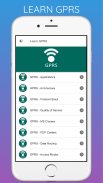


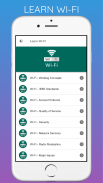

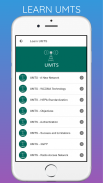
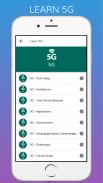
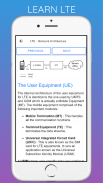
Learn All Telecom Technology Tutorials Offline ⭐️

Beschreibung von Learn All Telecom Technology Tutorials Offline ⭐️
Learn 5G
5G is the Fifth Generation technology. It has many advanced features potential enough to solve many of the problems of our mundane life.
Learn CDMA
Code Division Multiple Access (CDMA) is a channel access method normally used by 3G radio communication technology as well as in some other technologies.
Learn FTTH
More commonly known as “Future Proof”, Fiber to the home (FTTH) is a new technology to deliver a communication signal over optical fiber. It is an efficient and economic substitute of existing copper infrastructure including telephone and coaxial cable.
Learn GPRS
General Packet Radio Service (GPRS) is a Mobile Data Service accessible to GSM and IS-136 mobile phones users. This service is packet-switched and several number of users can divide the same transmission channel for transmitting the data.
Learn GSM
This tutorial has been designed for readers who want to understand the basics of GSM in very simple terms. This tutorial provides just about enough material to have a solid foundation on GSM from where you can move on to higher levels of expertise.
Learn i-mode
NTT DoCoMo's i-mode is a mobile internet service popular in Japan. i-Mode was invented by a team led by Mari Matsunaga in February 1999 at NTT DoCoMo. This tutorial explains the basic concepts and applications of i-Mode.
Learn LTE
This tutorial has been designed for audiences with a need to understand the LTE technology basics in very simple terms. This tutorial will give you enough understanding on LTE technology from where you can take yourself at higher level of expertise.
Learn NGN
Next Generation Networks (NGN) is a part of present-day telecommunication system, which is equipped with capabilities to transport all sorts of media, such as voice, video, streaming audio/video, text, etc. NGN is developed around the concept of packet switching as in Internet Protocol architecture.
Learn Session Initiation Protocol
SIP is a signalling protocol designed to create, modify, and terminate a multimedia session over the Internet Protocol. It is an application layer protocol that incorporates many elements of the Hypertext Transfer Protocol (HTTP) and the Simple Mail Transfer Protocol (SMTP).
Learn Telecom Billing
Telecom Billing is a process of collecting usage, aggregating it, applying required charges and finally generating invoices for the customers. Telecom Billing process also includes receiving and recording payments from the customers. This tutorial gives you a complete understanding on Telecom Billing.
Telecommunication Switching Systems and Networks (TSSN)
This tutorial will help you understand the different aspects of telecommunication switching systems. It is designed to deliver knowledge about the basic concepts of telephony.
Learn UMTS
The Universal Mobile Telecommunications System (UMTS), based on the GSM standards, is a mobile cellular system of third generation that is maintained by 3GPP (3rd Generation Partnership Project).
Learn WAP
WAP is an international standard establishing how mobile devices can access information on the Internet. It is a widely used set of protocols used on wireless devices such as mobile phones and PDAs. This tutorial helps you in understanding WAP technology starting from its basics.
Learn Wi-Fi
WiFi is primarily a local area networking (LAN) technology designed to provide in-building broadband coverage. It is based on IEEE 802.11 specification. This tutorial gives you a basic understanding on WiFi.
Learn WiMAX
WiMAX is one of the hottest broadband wireless technologies around today.It is based on IEEE 802.16 specification and it is expected to deliver high quality broadband services. This is a brief tutorial that covers the fundamentals of WiMAX.
Learn WML
WML is an XML language used to specify content and user interface for WAP devices like PDA and Mobile Phones. The WAP forum provides a DTD for WML.
Lerne 5G
5G ist die Technologie der fünften Generation. Es verfügt über viele erweiterte Funktionen, die ausreichen, um viele der Probleme unseres alltäglichen Lebens zu lösen.
Lerne CDMA
CDMA (Code Division Multiple Access) ist eine Kanalzugriffsmethode, die normalerweise von der 3G-Funkkommunikationstechnologie sowie in einigen anderen Technologien verwendet wird.
Lerne FTTH
Fiber to the Home (FTTH), besser bekannt als „Future Proof“, ist eine neue Technologie zur Bereitstellung eines Kommunikationssignals über Glasfaser. Es ist ein effizienter und wirtschaftlicher Ersatz für die vorhandene Kupferinfrastruktur einschließlich Telefon und Koaxialkabel.
Lerne GPRS
Der General Packet Radio Service (GPRS) ist ein mobiler Datendienst, auf den Benutzer von GSM- und IS-136-Mobiltelefonen zugreifen können. Dieser Dienst ist paketvermittelt und mehrere Benutzer können denselben Übertragungskanal zum Übertragen der Daten teilen.
Lerne GSM
Dieses Tutorial wurde für Leser entwickelt, die die Grundlagen von GSM in sehr einfachen Worten verstehen möchten. Dieses Tutorial bietet gerade genug Material, um eine solide Grundlage für GSM zu haben, von wo aus Sie zu einem höheren Grad an Fachwissen übergehen können.
Lerne i-mode
Der i-mode von NTT DoCoMo ist ein in Japan beliebter mobiler Internetdienst. i-Mode wurde im Februar 1999 von einem Team unter der Leitung von Mari Matsunaga bei NTT DoCoMo erfunden. Dieses Tutorial erklärt die grundlegenden Konzepte und Anwendungen von i-Mode.
LTE lernen
Dieses Tutorial wurde für Zielgruppen entwickelt, die die Grundlagen der LTE-Technologie in sehr einfachen Worten verstehen möchten. Dieses Tutorial vermittelt Ihnen ausreichend Verständnis für die LTE-Technologie, von wo aus Sie sich auf ein höheres Maß an Fachwissen einarbeiten können.
Lerne NGN
Next Generation Networks (NGN) ist Teil des heutigen Telekommunikationssystems, das über Funktionen zum Transport aller Arten von Medien wie Sprache, Video, Streaming von Audio / Video, Text usw. verfügt. NGN basiert auf dem Konzept von Paketvermittlung wie in der Internetprotokollarchitektur.
Lernen Sie das Sitzungsinitiierungsprotokoll
SIP ist ein Signalisierungsprotokoll zum Erstellen, Ändern und Beenden einer Multimedia-Sitzung über das Internetprotokoll. Es handelt sich um ein Protokoll auf Anwendungsebene, das viele Elemente des Hypertext Transfer Protocol (HTTP) und des Simple Mail Transfer Protocol (SMTP) enthält.
Erfahren Sie mehr über Telekommunikationsabrechnung
Bei der Telekommunikationsabrechnung werden die Nutzung erfasst, aggregiert, die erforderlichen Gebühren erhoben und schließlich Rechnungen für die Kunden erstellt. Der Abrechnungsprozess für Telekommunikation umfasst auch den Empfang und die Aufzeichnung von Zahlungen von Kunden. Dieses Tutorial vermittelt Ihnen ein umfassendes Verständnis der Telekommunikationsabrechnung.
Telekommunikationsvermittlungssysteme und -netze (TSSN)
Dieses Tutorial hilft Ihnen, die verschiedenen Aspekte von Telekommunikationsvermittlungssystemen zu verstehen. Es soll Wissen über die Grundkonzepte der Telefonie vermitteln.
Lerne UMTS
Das Universal Mobile Telecommunications System (UMTS), das auf den GSM-Standards basiert, ist ein mobiles Mobilfunksystem der dritten Generation, das von 3GPP (3rd Generation Partnership Project) unterhalten wird.
Lerne WAP
WAP ist ein internationaler Standard, der festlegt, wie mobile Geräte auf Informationen im Internet zugreifen können. Es handelt sich um eine weit verbreitete Reihe von Protokollen, die auf drahtlosen Geräten wie Mobiltelefonen und PDAs verwendet werden. Dieses Tutorial hilft Ihnen dabei, die WAP-Technologie ausgehend von ihren Grundlagen zu verstehen.
Lernen Sie Wi-Fi
WiFi ist in erster Linie eine LAN-Technologie (Local Area Networking), die eine umfassende Breitbandabdeckung im Gebäude ermöglicht. Es basiert auf der IEEE 802.11-Spezifikation. Dieses Tutorial vermittelt Ihnen ein grundlegendes Verständnis von WiFi.
Lerne WiMAX
WiMAX ist eine der heißesten drahtlosen Breitbandtechnologien, die es derzeit gibt. Es basiert auf der IEEE 802.16-Spezifikation und wird voraussichtlich qualitativ hochwertige Breitbanddienste liefern. Dies ist ein kurzes Tutorial, das die Grundlagen von WiMAX behandelt.
Lerne WML
WML ist eine XML-Sprache, mit der Inhalt und Benutzeroberfläche für WAP-Geräte wie PDA und Mobiltelefone angegeben werden. Das WAP-Forum bietet eine DTD für WML.


























